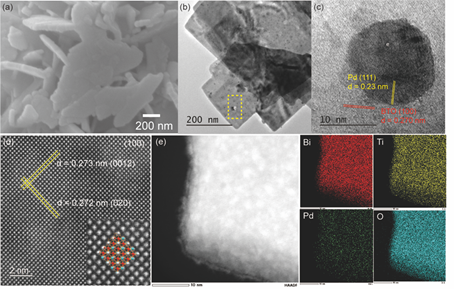Nitrogen oxides emitted through various anthropogenic combustion processes are one of the main air pollutants, directly or indirectly involved in environmental problems such as acid deposition, photochemical smog, haze and so on, which seriously affect air quality and human health.
Solar assisted photocatalytic purification provides a new idea to eliminate low concentration (ppb level) of nitrogen oxides from the atmosphere at ambient conditions, which has attracted widespread attention in recent years.
However, the limited light absorption, low charge separation efficiency and insufficient oxygen activation capacity have always been the key problems restricting the efficiency of photocatalytic purification.
Recently, it has been reported that the spontaneous polarized electric field generated by polar ferroelectric semiconductors can significantly improve the efficiency of bulk charge separation, and the surface charge transport can be synergistically enhanced through surface defect engineering and crystal plane structure construction.
Depositing precious metal nanoparticles is another popular strategy to tune electronic state of semiconductors, yet its effect on ferroelectric oxides and surface oxygen activation performance is unclear.
Recently, ZHANG Qian and HUANG Yu et al. from the Institute of Earth Environment of the Chinese Academy of Sciences(IEECAS), studied in detail the influence of loaded precious metal nanoparticles (Pd, Pt, Ag) on the interface electronic tuning and oxygen activation process, using the ferroelectric perovskite Bi4Ti3O12 nanosheet as a substrate.
They found that the crystalline Bi4Ti3O12 ferroelectric nanosheets were successfully prepared by microwave-assisted hydrothermal method, and the uniform loading of precious nanoparticles was achieved by in situ photo-deposition process (Fig.1).
Under the conditions of continuous testing, the Pd-Bi4Ti3O12 nanosheet composite structure showed the optimal NO removal rate and product selectivity, which significantly exceeded the performance of the Pd-TiO2 composite and the pristine Bi4Ti3O12 nanosheet, indicating that the synergistic enhancement of this strategy.
Combining a variety of advanced characterization techniques (spherical aberration electron microscopy, piezoelectric microscopy, photoluminescent spectroscopy, electron paramagnetic resonance and in situ diffuse reflection infrared Fourier transform spectra, and etc.) and density functional theory calculations, the in-depth analysis showed that Pd 4d orbital hot electron injection facilitated visible light harvest of Bi4Ti3O12 nanosheets.
In addition, the macroscopic polarization effect of Bi4Ti3O12 nanosheets combined with surface Pd nanoparticles modification significantly inhibits the bulk and interfacial charge recombination. The dominant reactive oxygen species formed by this composite structure is superoxide radical, which is different from the coexistence of hydroxyl radicals, peroxy radicals and superoxide radicals produced by Pt and Ag particles modified Bi4Ti3O12 nanosheets. This further explains the high activity and selectivity of Pd-Bi4Ti3O12 nanosheet composite structure.
The research, recently published in Applied Catalysis B: Environmental. has been jointly funded by the nanotechnology project of the Ministry of Science and Technology, the National Natural Science Foundation of China, the Western Young Scholars of the Chinese Academy of Sciences, and the Youth Innovation Promotion Association of the Chinese Academy of Sciences.

Fig. 1. Morphology and structural characterization of Pd-Bi4Ti3O12 nanosheet composite(Image by ZHANG, et al)
Contact: Bai Jie, Institute of Earth Environment, Chinese Academy of Sciences, Xi'an, China. Email: baijie@ieecas.cn
 © 2015 Institute of Earth Environment,CAS
© 2015 Institute of Earth Environment,CAS Address:No. 97 Yanxiang Road, Xi'an 710061, Shaanxi, China

 Location :
Location :